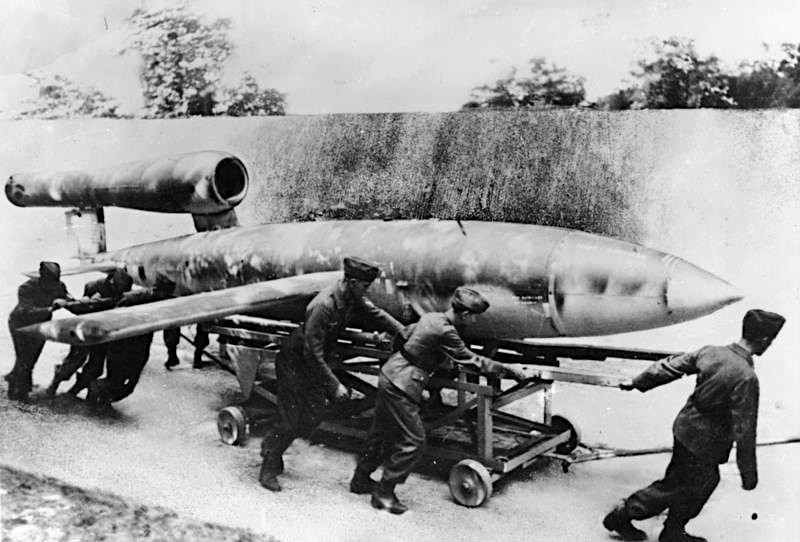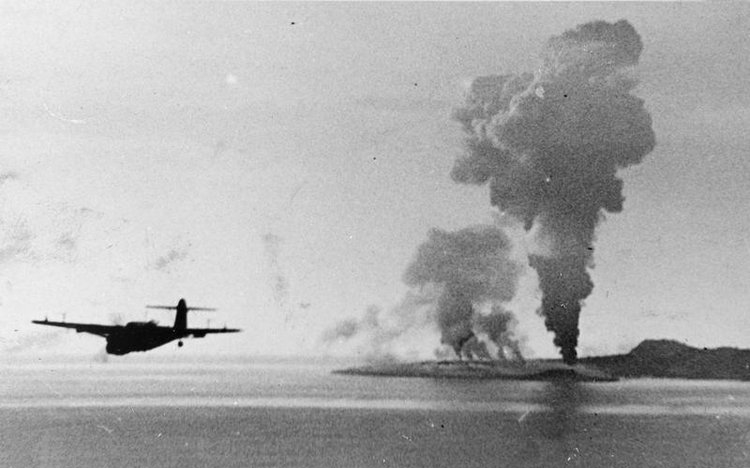I Was There! - I Visited a Bombed-Out Flying-Bomb Site
The War Illustrated, Volume 8, No. 188, Page 249-250, September 1, 1944.
Pointed at Bristol, bombed by Allied Air Forces into abandonment, a flying bomb installation at Martinvast, Normandy, has been inspected by war correspondent Peter Duffield. His story, and interview with the former owners of the site, appear here by arrangement with the Evening Standard.
Five years ago, in the uneasy but peaceful summer of 1939, Count and Countess Hubert Pourtales lived in one of Normandy’s truly idyllic chateaux. They lived as they had always lived, smoothly and gently. The Count, then 76, was serving his forty-eighth year as mayor of the tiny hamlet of Martinvast, six kms south of Cherbourg. A herd of fine Normandy cattle grazed over his rich green 250-acre dairy farm. His foals were numbered among the finest French thoroughbreds. His castle, filled with treasured furnishings and unsurpassed tapestries, was one of Normandy’s show pieces. You will find his horses in the Stud Book. The years passed...
Last November they began to build the great steel and concrete flying-bomb site on the Count’s green, wooded acres. They came in hordes. German workers, foreign workers, enlisted French workers. Tented camps sprang up under the hedges and the trees. A new German regiment moved into the chateau- an A.A. command which elbowed the count, countess and their 53 year old daughter, Countess d’Hauteville, still closer into their tree remaining rooms. The fields were porcupined with Hun emplacements. Everything was camouflaged. The work went on in November and December. The year 1943 turned.
"The first time you raided us," said the Countess d’Hautville, "was on January 14th at 9 p.m. How could I forget? It was apparent that they knew the location of the bomb site, guarded, hidden and secret as it was. And you must have known the chateau was the German H.Q."
The first raid burned half the chateaux almost beyond recognition, blew great gashes in the sturdy old masonry, crushed one tower, obliterated the tennis court, smashed every window-and blew the German H.Q. clean out of the castle. "They left first thing next morning," said the countess, "taking nearly all our furniture, looting and drinking their way from Martinvast."
For a time the count and his family were left alone both by the Germans and the Allied Air Force. Furnitureless, they moved out to the little lodge at the end of their avenue drive, but the Germans came back, and so did the bombing.
"The next big raid," said the countess, "was on May 8th, when the bomb-site and the castle were again attacked. That time you set the farm on fire. There were some Germans hiding there, but only one of them were killed. During the May 13th raid we hid in the old eleventh-century tower, which is the oldest part of the chateaux. By then we were alone at nights except for the surrounding A.A. gunners. The workers no longer remained in the camps during the night. They had been driven by your bombing to Barnville, about 15 kilometres away. They used to come to work every morning by bus. Yes, the raids did some good."
As the tall, white-haired Countess d’Hautville made that selfless remark to me today she was standing among the ruins of her once beautiful home. Through the empty crusts of arched windows we looked out on the acres where a torrent of high explosives had fallen. There, in the bomb pitted pastureland, the last foal of a long lineage of thoroughbred horses had toppled dead in the bombing.
Behind us, as we stood gingerly on some remaining floorboards, the rooms were bare of all save dirt and debris. Pieces of finely carved ceiling, shreds of tapestry, sections of carved stone mantelshelves, alone bore witness to bygone beauty.
"Yes," she repeated, "the raids did some good. I have never seen our bomb site. Always we were told to keep away. It was secret, very secret, they told us. Even the French workers were unable to get information."
We took the Countess on her first visit to the bomb site. She looked silently at the long, twin concrete ramps, the curving bombproof storage tunnels, the concrete assembly hangar, the narrow gauge rails that were to transport the bomb to the ramp, the sunken, apparently non-magnetic, pillar box where the gyro was to be adjusted and controls set.
We inspected one element of the emplacement after another. It was scattered over perhaps 30 acres of her ground, each section small and remote from the others. It was superbly camouflaged, surely invisible from the air. We saw no direct hits on concrete buildings themselves, but craters pitted the linking roadways and the warm, rich acres of earth between sections. There was no doubt of the delaying effectiveness of the Allied bombings!
 Dragged on a wooden trolley, this flying bomb is being moved to a launching ramp in France for discharge against Southern England. This is the first German official photograph to reach this country of "Revenge Weapon Number One" at its starting-point. See the accompanying story. Photo, Daily Express.
Dragged on a wooden trolley, this flying bomb is being moved to a launching ramp in France for discharge against Southern England. This is the first German official photograph to reach this country of "Revenge Weapon Number One" at its starting-point. See the accompanying story. Photo, Daily Express.
Historical context, by the webmaster
Photo: Bundesarchiv, Bild 146-1975-117-26 / Lysiak / CC-BY-SA 3.0
Previous and next article from I Was There!
I Was There! - We Pounded the Japanese Stronghold of Sabang
The crippling 35 minute surprise attack by Admiral Somerville’s Eastern Fleet on July 25th, 1944, against the dockyard, harbour installations, wireless equipment and workshops at Sabang, the Japanese-
I Was There! - When those Victory Salvos Roar in Moscow
Since the guns of Moscow fired their first thunderous salvos in August 1943 in celebration of the liberation of Orel, there have been many scores of these salutes to enliven and encourage the Muscovit
Index
Previous article
I Was There! - We Pounded the Japanese Stronghold of Sabang
The crippling 35 minute surprise attack by Admiral Somerville’s Eastern Fleet on July 25th, 1944, against the dockyard, harbour installations, wireless equipment and workshops at Sabang, the Japanese-
Next article
I Was There! - When those Victory Salvos Roar in Moscow
Since the guns of Moscow fired their first thunderous salvos in August 1943 in celebration of the liberation of Orel, there have been many scores of these salutes to enliven and encourage the Muscovit




